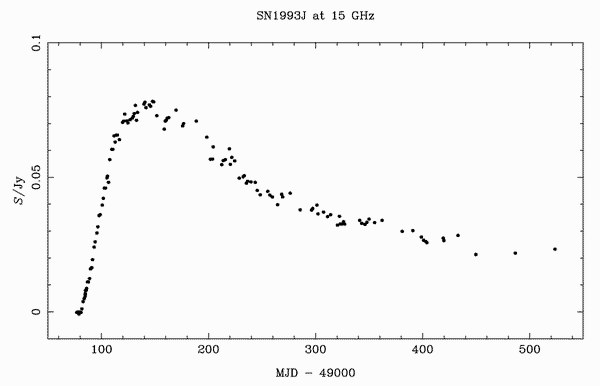Note: from 2024 January my webpages, previously hosted on https://www.mrao.cam.ac.uk/~dag/, are now being hosted on https://people.phy.cam.ac.uk/dag9/ instead. Please revise any bookmarks/links pointing to the old webpages.
SN1993J at 15.2 GHz
D.A. Green and G.G. Pooley
The figure and data below give the radio flux density of SN1993J at 15.2 GHz,
as observed by the Ryle Telescope.
- The observations for the first 115 days after the SN explosion have been
published previously by Pooley G.G. & Green D.A. (1993, MNRAS, 264, L17),
whereas the data presented here extend to about 500 days after the SN
explosion.
- These extended results are also displayed in Ho L.C., Van Dyk S.D., Pooley G.G., Sramek R.A. & Weiler
K.W. (1999, AJ, 118, 843), together with Ryle observations of the variation
of the core of M81 at 15.2 GHz (and VLA observations at other frequencies).
- The data below are for Stokes parameter I+Q, and have been
recalibrated, based on a flux density of 1.70 Jy for 3C48 and a smooth
variation in the flux density of the nearby calibrator source B0954+658.
Therefore there are small differences in flux densities for the first 115 days
compared with those previously published.
- The MJD is given for the centre of each observation, which vary in
duration, but are typically 1 to 2 hours long. The uncertainty in flux
densities are thought to be better than 5 per cent, due to uncertainties in the
flux density calibration.

The data are available as an ascii file. If you
wish to use these data, please cite both the published Pooley
G.G. & Green D.A. (1993) paper, and also a private communication from
Green D.A. & Pooley G.G. for these extended data.


